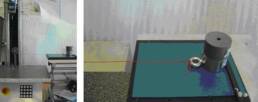Improvement of the sliding friction of conventional coatings Filling with compounds
test execution
The aim of this test is to improve existing coating systems with regard to their sliding friction properties by filling them with compounds. First of all, the coefficients of sliding friction of the unfilled paints were determined using the following test setup.
DIN A5 stainless steel plates (V2A steel) were coated with the respective systems. A sample plate was then fixed next to a tensile testing machine from Thümler and a stainless steel weight weighing 1000 g was placed on the coating (see Figures 1 and 2).

The weight was connected to the load cell of the tensile testing machine with a nylon cord and was pulled horizontally over the sample plate at a speed of 100 mm / min. The measuring path was 150 mm, 10% from the beginning of the measuring path and 5% from the end of the measuring path were not evaluated. The sliding friction force with which the weight was pulled over the sample was measured by the tensile testing machine. Five such measurements were made on each sample.
![]()
With the normal force FN and the measured sliding friction force FG could then the sliding friction coefficient μD calculated as follows:
![]()
Result:
And finally ...
We were able to significantly improve the sliding properties of conventional coating systems with our compounds. This compounding has resulted in an improvement of up to 40%.
The coefficient of sliding friction from steel to steel is 0,18.
Remember, this value is four and a half times that of our newly formulated systems. Thus, our coatings represent a significant improvement over conventional systems.

